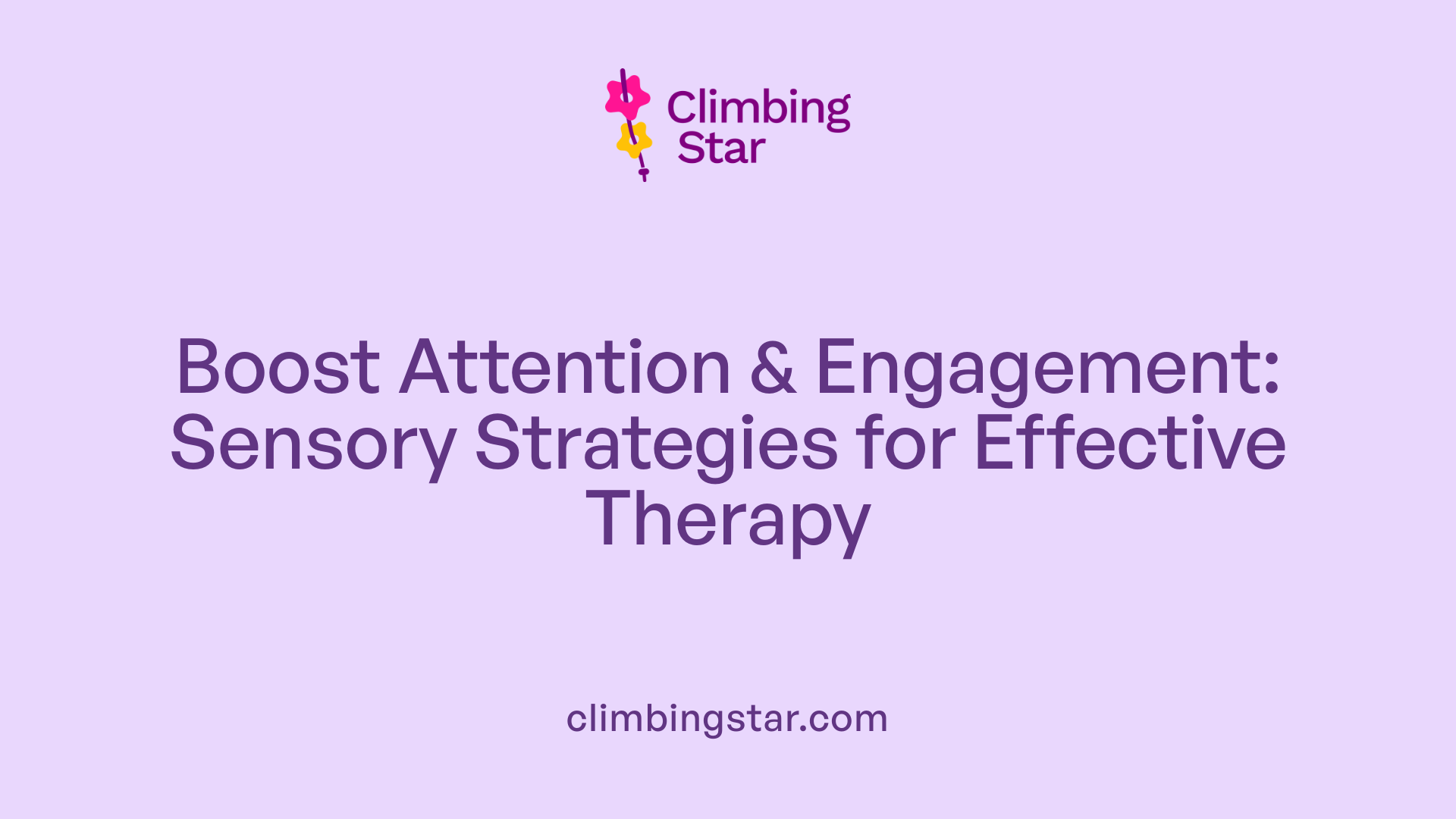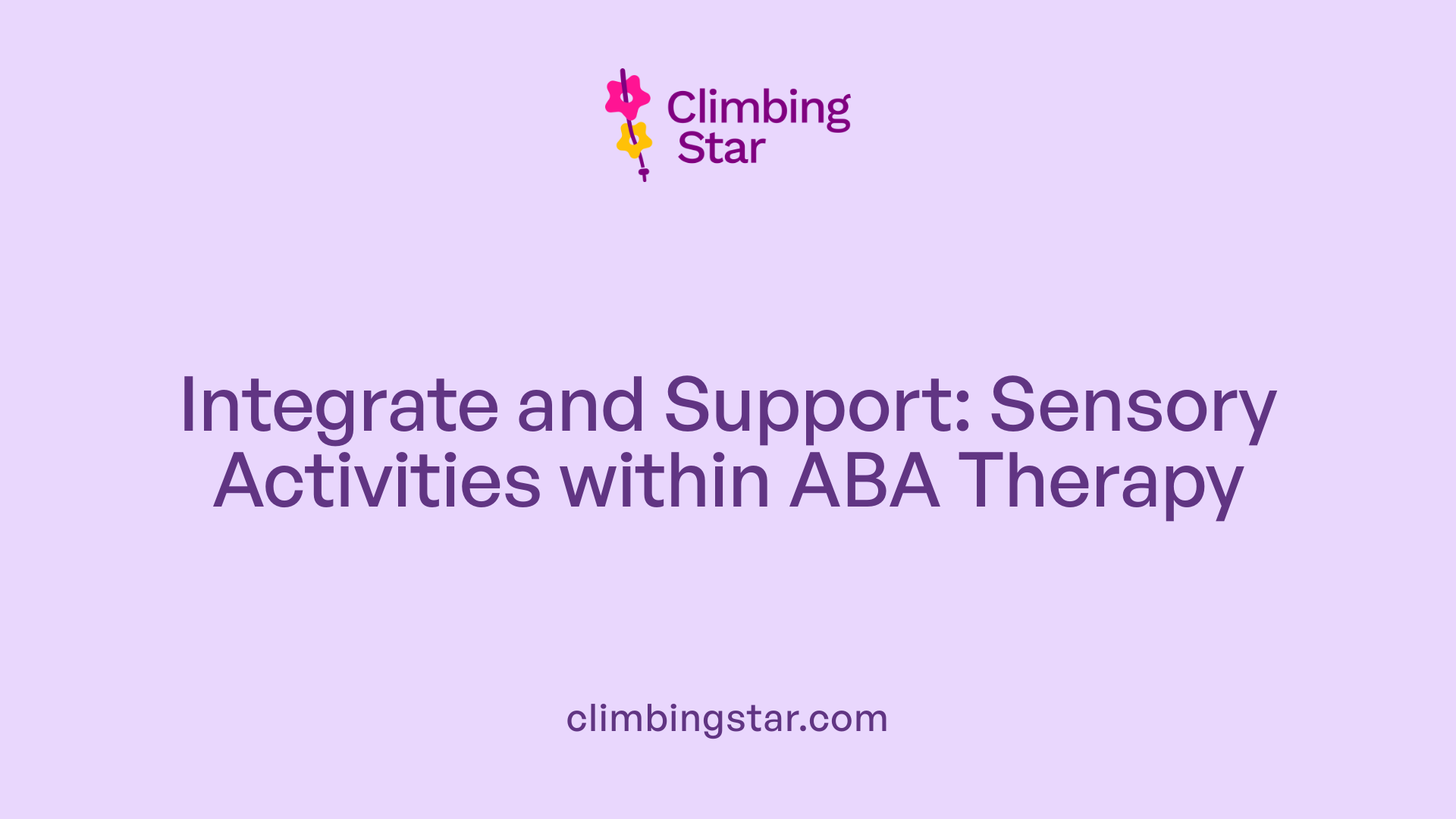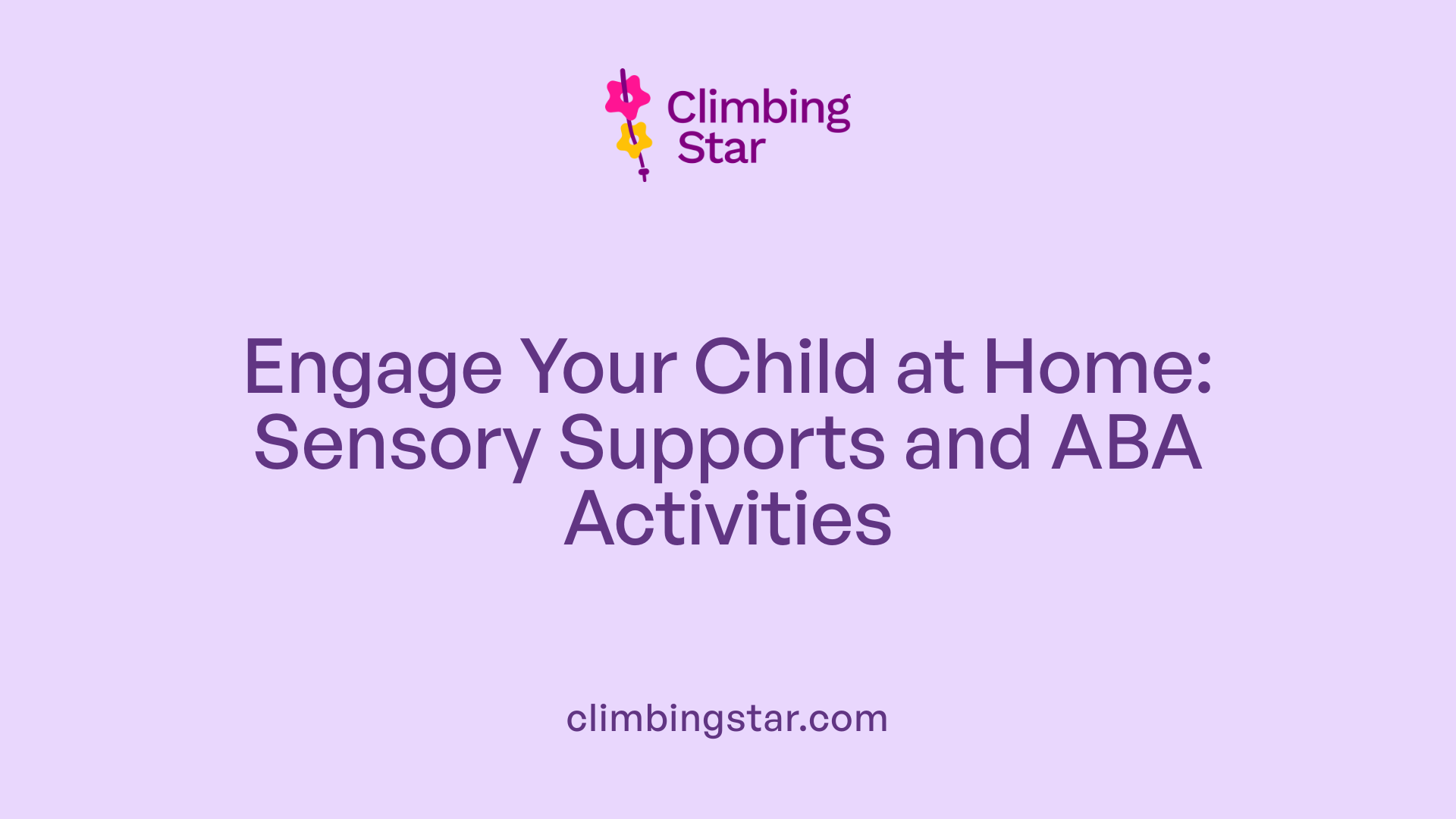Understanding Sensory Processing in Autism
Children with autism spectrum disorder (ASD) face unique sensory-processing challenges that influence their daily experiences, learning, and therapy engagement. Sensory activities tailored to address these challenges not only enhance their participation in various tasks but also complement therapeutic approaches like Applied Behavior Analysis (ABA) therapy. This article explores the nature of sensory processing differences in children with autism, the role of sensory activities, and how integrating sensory strategies within ABA therapy can promote developmental progress and improve quality of life.
The Role of Sensory Processing in Autism Spectrum Disorder
What sensory systems are involved in sensory processing?
Sensory processing is the way the nervous system receives and organizes information from the environment through seven main sensory systems. These include the vestibular system (balance and movement), proprioceptive system (body position), tactile system (touch), visual system (sight), auditory system (hearing), gustatory system (taste), and olfactory system (smell). All these systems work together to help a child make sense of the world around them.
How common are sensory-processing differences in children with ASD and what impact do they have?
Sensory-processing differences affect between 70 to 96 percent of children with Autism Spectrum Disorder (ASD). These differences significantly influence a child's ability to participate in social activities, play, school tasks, and self-care. They also affect critical areas such as attention span and communication development.
Children with ASD may demonstrate either heightened sensitivity (hyper-reactivity) or reduced sensitivity (hypo-reactivity) to sensory input. For example, some may react strongly to sounds or textures that others barely notice, while others may seek additional sensory input through repetitive actions like swinging. These sensory responses can affect learning and therapy participation.
Recognizing these sensory processing challenges is essential for tailoring effective interventions. Addressing sensory needs helps children with ASD engage better in daily activities and therapeutic sessions, enhancing overall developmental progress.
Hyper-Reactivity and Hypo-Reactivity: Understanding Sensory Responses in ASD
How do children with ASD experience sensory input differently?
Children with Autism Spectrum Disorder (ASD) often process sensory information in unique ways. They may show either hyper-reactivity or hypo-reactivity to sensory stimuli, which affects their behavior and learning.
What is hyper-reactivity and hypo-reactivity in ASD?
Hyper-reactivity refers to an increased sensitivity where children respond intensely to stimuli that others might not even notice. For example, a child may cover their ears at everyday sounds or be distressed by certain textures.
Hypo-reactivity is characterized by a reduced response to sensory input. Children may seek extra sensory experiences—for instance, they might engage in repetitive movements like constant swinging to feel more stimulation.
How do these sensory responses impact behavior and treatment?
These atypical sensory reactions can interfere with learning and therapy. Hyper-reactive behaviors might include withdrawal or avoidance, making it difficult for the child to engage in treatment activities. Hypo-reactive behaviors, on the other hand, may result in the child appearing inattentive or disconnected.
Understanding these sensory differences is crucial for therapists and caregivers to create supportive environments and effective interventions that accommodate each child's sensory needs, promoting better participation and progress in educational and therapeutic settings.
Occupational Therapy Interventions to Support Sensory Processing

What is the role of occupational therapists in supporting children with ASD?
Occupational therapists play a crucial role in addressing sensory-processing challenges experienced by many children with autism spectrum disorder (ASD). They assess each child's unique sensory needs and develop individualized interventions to improve participation in daily activities, including therapy sessions.
How do sensory integration techniques help?
Sensory integration techniques involve providing controlled sensory experiences to help the nervous system better organize and respond to sensory input. Therapists may use play-based activities that stimulate various senses such as vestibular (balance), tactile (touch), and proprioceptive (body position) systems. These techniques aim to reduce hyper- or hypo-reactivity and improve self-regulation.
What role does movement and proprioceptive input play?
Movement activities like jumping, swinging, or climbing provide vestibular input, which helps children with ASD regulate arousal and attention. Proprioceptive input through weight-bearing exercises or pushing/pulling games enhances body awareness and can calm sensory over-responsivity. These interventions support better focus and engagement during therapy.
How are deep-pressure tactile interventions used?
Deep-pressure tactile input, such as massages or using tools like therapy balls for gentle squeezing, helps improve body calmness and reduce anxiety in children who experience sensory over-responsivity. Incorporating these tactile strategies can increase a child's readiness to participate actively in therapy and learning activities.
By combining these sensory-based strategies, occupational therapists create supportive environments tailored to each child's sensory profile, promoting improved attention, engagement, and communication development.
Sensory Strategies to Enhance Attention and Engagement in Therapy

Modifying Arousal Levels to Support Attention
Sensory strategies play a crucial role in adjusting arousal levels to help children with autism spectrum disorder (ASD) focus and engage better during therapy sessions. By either calming an overactive sensory system or stimulating an under-responsive one, these interventions enable children to better attend to therapy tasks.
Tailoring Interventions to Individual Needs
Each child with ASD has unique sensory processing patterns, ranging from hypersensitivity to hyposensitivity across seven sensory systems—including vestibular, proprioceptive, tactile, visual, auditory, gustatory, and olfactory. Therapists customize sensory strategies to address these needs, using observations and assessments to determine the most effective methods for promoting attention and engagement.
Environmental Modifications to Enhance Participation
Adjusting the therapeutic environment can significantly aid a child's ability to focus. This may include introducing calming props such as weighted vests or body socks that provide deep-pressure tactile input, creating physical boundaries or tunnels to define space clearly, or reducing sensory distractions. These modifications help reduce sensory overload, leading to improved body calmness and participation.
Incorporating Targeted Physical Activities
Physical activities aimed at providing vestibular and proprioceptive input—like jumping, swinging, weight-bearing tasks, or ball squishes—are integrated into therapy to regulate sensory input. These activities help children maintain an optimal arousal state conducive to learning, thereby enhancing their capacity to concentrate on communication and behavioral goals.
Together, these sensory strategies form a comprehensive approach to support children with ASD in achieving better attention spans, improved eye contact, greater engagement, and meaningful progress during therapy sessions.
Sensory Tools and Equipment to Calm and Focus Children with ASD
Sensory Tools and Equipment to Calm and Focus Children with ASD
Children with autism spectrum disorder (ASD) often experience sensory-processing differences that affect their attention, behavior, and participation in therapy. Sensory tools like weighted vests, body socks, physical boundaries, and tunnels are commonly used to support these children in managing sensory over-responsivity.
Weighted vests provide deep-pressure input, which can help soothe and calm children who are hyper-reactive to sensory stimuli. This calming effect often leads to improved body calmness, which is essential for better focus and engagement during therapy or learning activities.
Body socks similarly provide a sense of containment and proprioceptive feedback, helping children to regulate their body awareness and decrease anxiety. This tool allows children to feel more grounded, promoting a quieter and more attentive state.
Physical boundaries such as mats or designated spaces create clear spatial limits that help children feel secure and reduce distractions. These boundaries give children a defined area where they can remain focused and less overwhelmed by environmental factors.
Tunnels encourage movement and vestibular input, offering a fun and motivating way to incorporate sensory activities. They help children seek and organize sensory input in a controlled manner while promoting motor planning and social interaction.
Collectively, these sensory tools improve body calmness and enhance children's attention and participation in therapy sessions. Therapists observe that when sensory needs are addressed through such equipment, children with ASD show better eye contact, increased engagement, and greater progress toward communication and behavioral goals.
Integrating Sensory Activities within ABA Therapy for Children with Autism

What is Applied Behavior Analysis (ABA) therapy and how is it used in treating autism?
Applied Behavior Analysis (ABA) therapy is a highly effective, evidence-based approach used to improve social, communication, and adaptive skills in children with autism. It works by applying learning principles such as positive reinforcement, prompting, and modeling to encourage desirable behaviors and reduce challenging ones. ABA programs are often tailored specifically to each child's needs, using techniques like behavior chaining and the ABC (Antecedent-Behavior-Consequence) framework to understand and address behaviors. Therapy can take place in various environments, including the home, school, or community settings, often supervised by certified professionals.
How are sensory activities incorporated into ABA therapy?
Children with autism frequently experience sensory-processing differences, which can greatly impact their learning and engagement. To tackle this, sensory activities are integrated within ABA therapy to help regulate arousal and attention levels. For example, clinicians might recommend movement-based inputs such as swinging or jumping (vestibular), proprioceptive activities like weight-bearing exercises, or deep-pressure inputs such as massages. These interventions help children manage their sensory sensitivities—whether they are hyper-reactive or hypo-reactive to stimuli—allowing them to better focus and participate during therapy sessions.
What improvements are seen in attention and communication?
Incorporating sensory strategies into ABA therapy helps children enhance their body calmness and maintain better attention spans. With improved regulation, children often show increased eye contact, greater engagement with peers and therapists, and notable progress toward communication goals. These changes contribute to a more productive therapy experience and support overall skill development in behavioral, social, and communication domains.
What role do therapists play in integrating sensory strategies?
Speech-language pathologists (SLPs), occupational therapists, and behavior analysts collaborate to address the sensory needs of children on the autism spectrum. The therapists conduct thorough assessments to identify each child's unique sensory processing profile. They then design individualized interventions, combining sensory strategies with ABA techniques, to promote participation and learning. Use of visual supports, environmental adjustments, and sensory tools like weighted vests or body socks are frequently recommended. This multidisciplinary approach ensures therapy is both accessible and effective, leveraging parental involvement and tailored activities to foster optimal growth and development.
Who Provides ABA Therapy and Their Qualifications
ABA Therapy Providers and Their Roles
ABA therapy is delivered by a team of professionals with distinct roles and qualifications. The primary providers include Board Certified Behavior Analysts (BCBAs), Board Certified Assistant Behavior Analysts (BCaBAs), and Registered Behavior Technicians (RBTs).
What Qualifications Do These Professionals Have?
BCBAs hold graduate-level degrees and are responsible for designing and supervising individualized treatment plans. They must complete supervised fieldwork and pass a certification exam to earn their credential.
BCaBAs support BCBAs by assisting in treatment implementation and supervising RBTs. Their qualifications require undergraduate coursework, supervised experience, and certification.
RBTs are paraprofessionals who provide direct therapy to clients. Their responsibilities include implementing specific intervention plans and collecting data on progress. To become an RBT, one must complete specialized training and pass competency assessments.
Training, Certification, and Professional Standards
All these professionals must adhere to ongoing education requirements to maintain their certifications, ensuring their skills remain current. Ethical standards guide their practice to provide effective and respectful care for individuals with autism. Additionally, some may need state licensure to practice independently, varying by location.
This system ensures that children receiving ABA therapy have access to knowledgeable and qualified practitioners dedicated to supporting their developmental and behavioral goals.
The Structure and Process of an ABA Therapy Program for Children with Autism
What is the typical process or structure of an ABA therapy program?
ABA (Applied Behavior Analysis) therapy programs for children with autism begin by conducting a Functional Behavior Assessment (FBA). This assessment identifies the underlying reasons behind specific behaviors and helps in developing a personalized treatment plan tailored to each child's unique needs.
Following the FBA, clear and measurable goals are set. These goals target improvements in areas such as communication, social skills, self-care, and academic abilities, alongside reducing challenging behaviors that may interfere with learning and social interaction.
Throughout the program, various ABA techniques are applied systematically. Common methods include positive reinforcement to encourage desirable behaviors, prompting to guide new skills, shaping to gradually build complex behaviors, and fading to decrease prompts as the child gains independence.
Family involvement is a crucial component of successful ABA programs. Parents and caregivers are often trained to implement strategies and activities at home, reinforcing skills learned during therapy sessions. This collaboration helps generalize skills across settings and maximizes progress.
Data collection is ongoing during therapy. Therapists carefully record observations on the child's behavior and skill acquisition to monitor progress. This data allows the team to make informed adjustments to the intervention plan, ensuring it remains effective and responsive to the child's development.
Overall, ABA therapy follows a structured, step-by-step approach focused on skill acquisition, making use of child-centered and engaging strategies. By increasing beneficial behaviors and promoting independence, ABA programs aim to improve the child's quality of life and ability to participate fully in daily activities.
Behavioral Challenges Addressed through ABA Therapy
What types of behavioral issues are addressed through ABA therapy in autism treatment?
ABA (Applied Behavior Analysis) therapy is a comprehensive approach designed to tackle various behavioral challenges faced by individuals with autism spectrum disorder (ASD). It primarily focuses on enhancing communication skills, reducing social skill deficits, and addressing repetitive behaviors that often interfere with daily functioning.
Communication challenges are a major target in ABA therapy. This includes improving verbal and non-verbal communication, such as increasing eye contact, enhancing understanding and use of language, and developing alternative communication methods like AAC (Augmentative and Alternative Communication) apps. Social skill deficits, such as difficulties in engaging with peers, understanding social cues, and building relationships, are also addressed through structured activities and reinforcement techniques.
Repetitive behaviors, which may include stereotyped movements or limited interests, are managed by identifying their triggers and teaching more adaptive behaviors. ABA also effectively reduces problematic behavior like aggression, self-injury, tantrums, and non-compliance by promoting positive alternatives and reinforcing desired behaviors.
Moreover, ABA therapy supports improvements in daily living skills such as dressing, eating, following instructions, and increasing attention span. Targeting these skills helps children gain greater independence and better participation in home and school environments.
The therapy also addresses co-occurring issues like anxiety, obsessive behaviors, and feeding difficulties, contributing to overall well-being and quality of life. Its individualized programming, guided by ongoing data collection and analysis, ensures that interventions are tailored to each child's unique needs and developmental level.
By emphasizing early intervention and parental involvement, ABA therapy facilitates meaningful skill acquisition that can significantly reduce undesirable behaviors and improve functional outcomes in children with ASD.
Sensory-Based Activities Parents Can Use at Home to Support ABA Therapy

How can parents use ABA activities at home to support their children with autism?
Applied Behavior Analysis (ABA) therapy is a powerful tool for helping children with autism develop essential behavioral, communication, and social skills. Parents can play a vital role by implementing ABA activities at home that incorporate sensory supports tailored to their child's unique needs.
Examples of ABA activities at home
Parents can encourage their child to sit in a chair to improve focus and concentration during tasks. Using visual supports, such as matching colors or identifying emotions through photos, helps children process information and stay engaged. Flashcards are excellent for skills like alphabet recognition, while building blocks and puzzles provide hands-on learning that promotes problem-solving and fine motor skills.
Visual supports and reinforcement
Visual aids like bubbles can be used to encourage eye contact and social interaction, which are fundamental in communication development. Reinforcement strategies—including positive feedback when the child completes a task or gentle correction for unwanted behaviors—help motivate learning and promote skill acquisition.
Engaging tools like bubbles and flashcards
Bubbles are more than just fun; they can capture a child's attention and foster focus during therapy-related activities. Similarly, flashcards serve as effective tools for teaching concepts in a structured way, helping to break down complex skills into manageable steps.
Importance of parental involvement
Parental involvement is critical for success in home-based ABA activities. When parents actively engage in these sensory-supported exercises, children often show improved attention spans, better eye contact, and increased participation. This consistency between home and professional therapy sessions maximizes progress, especially when access to clinical services may be limited.
By integrating these sensory-friendly ABA strategies at home, parents can create a supportive environment that encourages their child's growth and helps them thrive both in therapy and daily life.
The Impact of Early Intervention with ABA and Sensory Activities

How does early intervention with ABA therapy impact children with autism?
Early intervention using Applied Behavior Analysis (ABA) therapy significantly benefits children with autism by tapping into the brain's neuroplasticity during critical developmental windows. By an early start, children can make remarkable gains in communication skills, social interaction, and adaptive behaviors.
ABA programs are personalized and intensive, focusing on developing essential life skills such as language, self-care, and socialization. This therapy also helps reduce challenging behaviors—including tantrums and aggression—through targeted strategies based on understanding behavioral functions.
Complementing ABA, sensory-processing interventions address challenges common in children with autism, who often have heightened or diminished responses to sensory input. Activities like deep-pressure tactile input (e.g., massage), movement-based exercises (e.g., swinging), and sensory integration techniques help regulate arousal levels, allowing better attention and engagement during therapy.
When these approaches are combined early, children tend to improve their eye contact, attention span, and participation in both therapy and daily activities. Parents can support development through home-based ABA activities such as using visual supports, reinforcing positive behaviors, offering structured routines, and incorporating technology aids like AAC apps.
Long-term outcomes of such early and integrated intervention efforts include greater independence, improved communication, and enhanced social skills. Children engaging in these therapies are more likely to progress academically and socially, building a foundation for a better quality of life.
Leveraging Sensory and Behavioral Strategies for Holistic Autism Support
Understanding and addressing sensory processing differences are essential components of effective autism therapy. Incorporating sensory activities into ABA therapy and daily routines enriches the therapeutic experience, improving attention, engagement, and communication for children with autism. Skilled professionals, including occupational therapists and certified ABA providers, collaborate to tailor interventions that meet each child's unique needs. With early and consistent intervention, supported by caregivers at home, children with autism can achieve significant developmental gains, better behavior regulation, and enhanced quality of life. Ultimately, integrating sensory strategies with behavioral therapy provides a comprehensive approach that fosters growth, independence, and meaningful participation across environments.
References
- Sensory Strategies to Calm and Engage Children with ...
- ABA Therapy Activities To Do At Home
- Types Of ABA Therapy Jobs And Their Degree Requirements
- Understanding Your Child's ABA Therapy Providers
- Applied Behavior Analysis (ABA)
- ABA Therapy Examples, Definition & Techniques
- ABA Techniques: Strategies for Behavior Analysts - GSEP Blog
- Applied Behavior Analysis (ABA)







